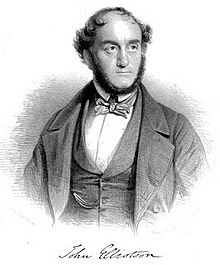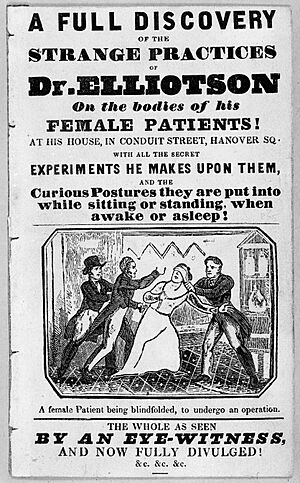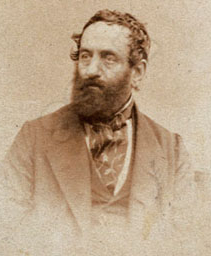John Elliotson facts for kids
Quick facts for kids
John Elliotson
|
|
|---|---|

John Elliotson
|
|
| Born | 29 October 1791 |
| Died | 29 July 1868 (aged 76) London
|
| Nationality | British |
| Alma mater | University of Edinburgh |
| Known for | Mesmerism, Phrenology, The Zoist, introducing stethoscope to United Kingdom |
| Scientific career | |
| Fields | Medicine |
| Influences | Thomas Brown |
John Elliotson (born 29 October 1791 – died 29 July 1868) was a very important British doctor. He was a professor at University College London and a senior doctor at University College Hospital.
Elliotson was known for being a great teacher and for his skill in figuring out what was wrong with patients. He was always trying new things in medicine. For example, he was one of the first doctors in Britain to use the stethoscope. He also used acupuncture to help people.
Contents
Early Life and Education
John Elliotson was born in Southwark, London, on 29 October 1791. His father was a successful chemist.
He studied medicine at the University of Edinburgh from 1805 to 1810. He also studied at Jesus College, Cambridge. Later, he continued his medical training at hospitals in London. In 1831, he became a professor at London University, which is now University College London. By 1834, he was a main doctor at University College Hospital.
A Unique Doctor
Elliotson was not very tall, about 152 cm (5 feet). He had a dark complexion and a very large head. He also had a limp from an accident.
Despite his looks, he was a very popular lecturer. People admired how clear and lively his talks were. His lectures were often written about in medical newspapers. He became the first President of the Royal Medical and Chirurgical Society in 1833. He was also a member of the Royal College of Physicians and the Royal Society. At his busiest, he had one of the largest private medical practices in London.
Phrenology and Mesmerism
Elliotson became very interested in two new ideas: phrenology and mesmerism.
What is Phrenology?
Phrenology was a belief that you could tell a person's character and mental abilities by feeling the bumps on their skull. Elliotson helped start the London Phrenological Society in 1823.
What is Mesmerism?
Mesmerism, also called "animal magnetism," was a practice where a person would try to put another person into a trance-like state. People believed this state could help with healing or even give special abilities. Elliotson first saw mesmerism in 1829 and became very interested in it again in 1837.
The Okey Sisters' Experiments
In 1837, Elliotson began experimenting with two young sisters, Elizabeth (17) and Jane Okey (15). They were in the hospital for epilepsy. Elliotson used them for public demonstrations of mesmerism. He believed that Elizabeth could see inside the body and diagnose illnesses while in a mesmeric trance.
The Controversy with Thomas Wakley
In 1838, a man named Thomas Wakley, who edited a medical journal called The Lancet, tested the Okey sisters. He wanted to see if they could tell the difference between "mesmerized" and "unmesmerized" water. When they failed to do this consistently, Wakley said they were faking it and that mesmerism was false.
Because of this controversy, Elliotson was forced to leave his job at the hospital by the end of 1838. The hospital decided that mesmerism should not be practiced there. Wakley continued to write articles against Elliotson in The Lancet.
The Zoist Journal
After leaving the hospital, Elliotson started a journal called The Zoist. He edited it with William Collins Engledue. The journal was published every three months from 1843 to 1856.
The Zoist was all about promoting mesmerism and phrenology. It shared stories and reports from doctors and others who used these practices. It especially focused on how mesmerism could help people feel less pain during surgery.
Later Life and Legacy
Even after losing his hospital job, Elliotson continued to give mesmeric demonstrations from his home. He also helped found the London Mesmeric Infirmary in 1849.
However, his reputation and his medical practice slowly declined. He died in 1868 without much money, at the home of a friend.
Literary Connections
Despite the controversies, John Elliotson was well-liked by famous writers.
William Makepeace Thackeray dedicated his novel The History of Pendennis to Elliotson. Thackeray also based a character, Dr. Goodenough, on Elliotson in his novel The Adventures of Philip. Elliotson had helped Thackeray when he was very ill.
Elliotson was also a friend of Charles Dickens and introduced him to mesmerism. Another writer, Wilkie Collins, called Elliotson "one of the greatest English physiologists."
See also
- The Zoist: A Journal of Cerebral Physiology & Mesmerism, and Their Applications to Human Welfare



